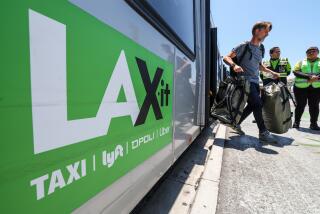Playing Fare : United’s Shuttle Gains Passengers; Southwest Expands
- Share via
Dianne Woods usually flies Southwest Airlines on her monthly business trips between Northern and Southern California. But last week, the 42-year-old social worker jumped ship.
Instead of Southwest, Woods flew on United Airlines’ new shuttle service.
“I’m not going to miss Southwest,” Woods said as she waited at Burbank Airport for her return flight to Oakland on Shuttle by United. “I’d rather fly United. I get my frequent flier miles.”
Since launching on Oct. 1, United’s low-fare shuttle has won over many passengers and forced rival Southwest to expand service along the West Coast. But Dallas-based Southwest shows no signs of losing control of the California skies, and United remains quiet on whether its shuttle is generating profits in addition to passenger traffic.
The shuttle, United’s answer to Southwest and other low-fare, low-cost carriers, will also come under heavy stress in the coming weeks. The hordes of holiday travelers and baggage--as well as inclement winter weather--could disrupt the shuttle’s frequent flights and on-time service. United said it is planning to deal with the crush; Southwest has more than 20 years of practice operating under such conditions.
United officials, however, are quick to crow about the shuttle’s first month of operating statistics, which they say exceed expectations. During October, the average shuttle flight was 71% full, United said.
At Los Angeles International Airport, United shuttle manager Jill Sheffield has another way to gauge success. On a company bulletin board, United workers have posted many of the Southwest baggage tags they have removed from the luggage of passengers now flying the shuttle, she said.
“We are picking up Southwest passengers,” Sheffield said. “We got quite a few posted” she said of the tags.
The shuttle was born out of a $5-billion deal completed in July that gave most of United’s workers majority ownership of the nation’s largest carrier in return for wage cuts and increased productivity.
Although the shuttle uses United employees and planes, its operations resemble those of Southwest. Planes spend as little as 20 minutes on the ground between flights to get the most efficient use of the aircraft. In-flight meals are limited to a snack and a beverage, and passengers have to wait until they get to the airport to get seat assignments. The shuttle has even adopted some of Southwest’s showmanship by offering a limited $9.97 one-way fare between Northern and Southern California for the Thanksgiving Day holiday.
In matching Southwest’s low fares and offering credit in United’s Mileage Plus frequent flier program, the shuttle has proved hard to resist for many United passengers who had been using Southwest for short trips. Mileage Plus members can redeem their credits for free trips to the many places United serves worldwide. Southwest frequent fliers can also earn free trips, but to a much smaller number of domestic cities.
“I’ll fly United if the price is the same (as Southwest) . . . and I get my Mileage Plus credits,” said one executive who was boarding a shuttle flight to San Francisco from Burbank.
Southwest has moved quickly to keep customers by adding flights and cutting fares, particularly within California. In late October, it introduced a special $39 one-way intrastate fare. On Tuesday, Southwest raised the number of round trips between Los Angeles and Oakland to 25 from 19. That route is now the busiest in the Southwest network.
Southwest has watched its low-fare franchise come under attack from a crop of start-ups such as Atlanta-based Value Jet and established carriers such as United and Continental Airlines that are cloning Southwest strategies. Southwest has fought back, and this week, for example, it signed a 10-year-long labor contract with its pilots that freezes pay for seven years in return for stock options.
But the airline’s stock price has taken a beating in the past year as investors have worried about Southwest wanna-bes. Last week, Southwest shares fell sharply after the company said its fleet flew with 65% of seats filled in October, contrasted with 68% for that month last year. On Friday, Southwest shares closed at $22.50, up 75 cents for the day but down from $39 earlier this year.
Southwest said its load factor--the portion of seats sold--was lower because traffic was abnormally high in 1993 and the airline had expanded its operations by more than 30% within the past year.
On the West Coast, United’s shuttle has had no noticeable impact on Southwest’s passenger traffic, Southwest spokeswoman Linda Burke Rutherford said. The airline said it is looking to continue expanding service within California and across the country.
United also plans to keep its shuttle growing by converting existing service and adding new flights. The shuttle now flies 130 round-trips daily and serves 12 places, including Burbank, Los Angeles, Ontario and San Diego in Southern California, and Oakland, Sacramento and San Francisco in the north. By Dec. 1, the shuttle will account for nearly half of all United flights at Los Angeles International Airport.
The most likely targets for expansion are large metropolitan areas situated less than 750 miles apart.
“Those kinds of areas make sense for the shuttle,” said Jim Hartigan, United western regional vice president. “We will continue to grow throughout the first quarter” of next year, he said.
More to Read
Inside the business of entertainment
The Wide Shot brings you news, analysis and insights on everything from streaming wars to production — and what it all means for the future.
You may occasionally receive promotional content from the Los Angeles Times.










